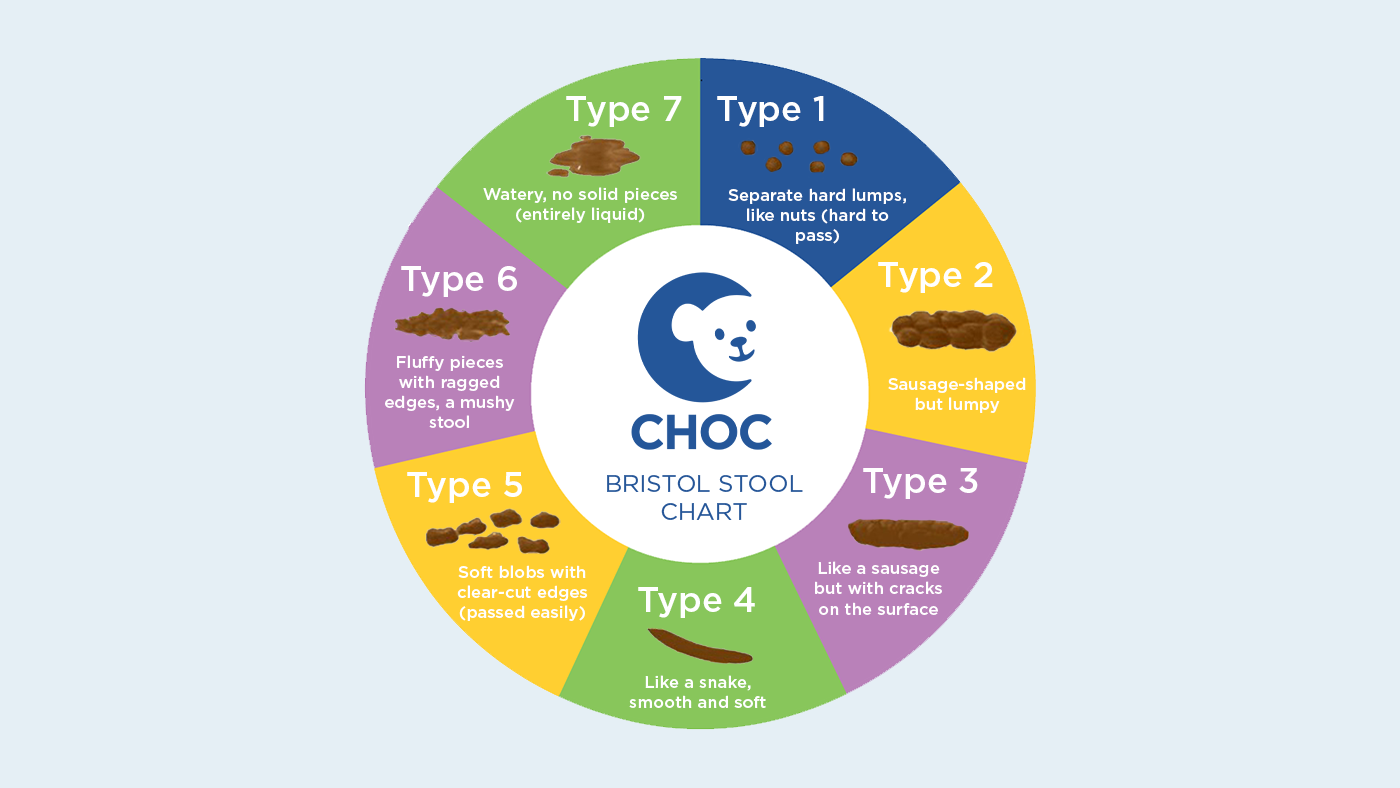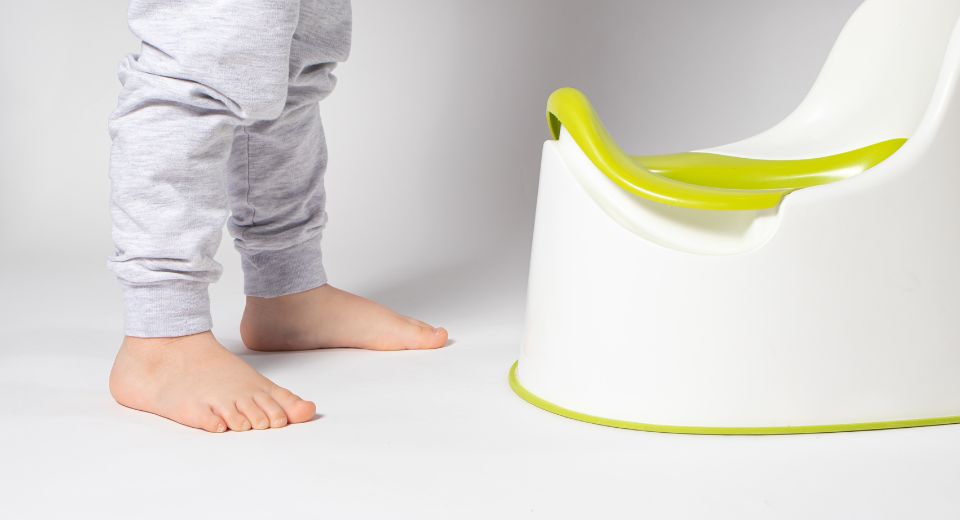What your kid’s poop color, shape and frequency can tell you about their health
For something that everyone does, there’s still so much mystery around poop – especially when it comes to kids.
In this ultimate guide to kids’ poop, a CHOC pediatric expert offers advice for parents on the full spectrum of poop, including stool color, frequency, diarrhea and constipation.
What is poop, really?
Poop is the last step of digestion for the body, says Dr. Monica Molina, a pediatrician in the CHOC Primary Care Network. After swallowing food, it heads to the stomach, then the small intestine, and then to the large intestine, or bowels. Throughout this process, the body soaks up water and nutrients from the food.
What’s left is poop. And after reaching the bowels, it comes out through the rectum and anus.
What color should a child’s poop be? What stool color really means.
A child’s poop color is normally any shade of brown, tan, yellow or green. White, black or red poop, however, may be a sign of disease, but Dr. Molina cautions that these colors may also be attributed to a child’s diet or other factors.
What if my child’s poop is a different color than that?
White poop in kids or light gray poop can be a sign of liver disease, says Dr. Molina. Blocked bile ducts in babies can lead to light gray or pale yellow stool. An all-milk diet, however, may also lead to white stool, as can certain medicines.
Black poop might be a sign of stomach bleeding because stomach acid might turn blood into a dark tar-like color, Dr. Molina says. Additionally, black stool can be caused by cigarette ashes or charcoal. It might also though be caused by foods like licorice or grape juice.
Red poop in a child can also be a sign of blood, though the vast majority of red stools in children are not caused by blood, Dr. Molina says. Red stool may also be the result of certain medications or foods, such as red frosting, paprika or tomato sauce. The following chart explains what each poop color might mean:
Green poop in kids is normal but sometimes may look black under poor lighting, says Dr. Molina. Green colored stools are typically caused by bile, certain foods and medicines. Green poop is common in diarrhea and is more typical in formula-fed babies than babies who are breastfed.
Dr. Molina says a parent should call the pediatrician if light gray stool or white poop occurs two or more times, or if poop continues to be a strange color (besides green) for more than 24 hours without a suspected cause. A parent should also call if the poop continues to be a strange color 48 hours after the suspected food or medicine was stopped.
How often should a baby or child poop?
How often everyone poops varies, but ideally a child should have a soft bowel movement each day, says Dr. Molina.
Initially, breastfed babies tend to poop more often than formula-fed babies because breast milk is more easily digested. However, at around ages 3 to 6 weeks, breastfed babies may start having fewer bowel movements, sometimes only one or two a week. Formula-fed babies usually continue to have daily bowel movements.
It’s normal for infants to strain when they’re pooping. Pooping is more of a challenge for them because they are lying flat and don’t have gravity to help.
The Bristol Stool Chart: What should poop look like?
This stool chart was developed to help doctors to talk about the shape and type of poop, or stools.
Ideally, a child’s bowel movement resembles type nos. 3 or 4 and passes easily without being too watery, says Dr. Molina.
Stool that looks like types 5, 6 or 7 are likely signs of diarrhea.
Poop that looks like type 1 or 2 is likely a sign of constipation.
A stool’s hardness is determined by how much water the body absorbs during digestion. Normally, as food moves through the large intestine, the colon absorbs water while forming poop. Muscle contractions then push the stool toward the rectum. By the time the stool reaches the rectum, most of the water has been absorbed, making the stool solid.
When the colon’s muscle contractions are slow or sluggish, the stool moves through the colon too slowly, resulting in too much water being absorbed.
Additionally, if a child is dehydrated, more water will be taken from the colon to provide water to the vital organs, resulting in harder stool.
The stool chart below will help you identify different types of stools:


What’s the best way to wipe?
It’s important to wipe from front to back. Wiping from back to front increases the risk of spreading bacteria from poop to the urethra, which can cause urinary tract infections.
For children and teens, regular toilet paper should do the trick. It’s normal for toddlers just learning to poop in the toilet and some smaller children to need help wiping.
For babies with delicate skin, a parent may use a wet washcloth, cotton balls or baby wipes to clean up after a bowel movement. Be sure to lift the baby’s legs by the ankles to get underneath, and don’t forget the creases in the thighs and buttocks.
Diarrhea
What is diarrhea?
Diarrhea is frequent soft or loose poop. Most kids have diarrhea from time to time. It usually doesn’t last long and often gets better on its own.
What causes diarrhea?
Diarrhea is usually caused by an infection in the intestines.
Viruses
Several types of viruses can cause diarrhea.
Viral gastroenteritis – often called the “stomach flu,” though unrelated to influenza – is a common illness in children. It causes diarrhea and, often, nausea and vomiting. The symptoms usually last a few days, but kids (especially babies) who can’t take enough liquids may become dehydrated.
Rotavirus affects babies and young kids and can bring on watery diarrhea. Outbreaks are more common in the winter and early spring months, especially in childcare centers. The rotavirus vaccine can protect children from this illness.
Enteroviruses, like coxsackievirus, also can cause diarrhea in kids, especially during the summer months.
Bacteria
Many different types of bacteria can cause diarrhea, including E. coli, Salmonella, Campylobacter, and Shigella. These bacteria are often responsible for cases of “food poisoning,” which can cause diarrhea and vomiting within a few hours after someone is infected.
Parasites
Parasitic infections that can cause diarrhea in children include giardiasis and cryptosporidiosis.
Is your child complaining of a stomachache? Learn more.
What else can cause diarrhea?
Beyond bacteria, viruses and parasites, diarrhea can be caused by a few other things:
- a high-sugar diet
- food allergies
- lactose intolerance
- problems in the intestines like celiac disease and inflammatory bowel disease (Crohn’s disease and ulcerative colitis)
What are the signs and symptoms of diarrhea?
Kids often get crampy belly pain first, followed by diarrhea that can last three to five days. Other symptoms may include:
- fever
- loss of appetite
- nausea
- vomiting
- weight loss
- dehydration
When should I call the doctor about diarrhea?
Parents of babies who have diarrhea and are younger than 6 months should call the pediatrician right away, Dr. Molina says.
Parents of older children should call the doctor if the child is experiencing these symptoms:
- diarrhea many times a day or it lasts for more than three days
- repeated vomiting and can’t or won’t drink fluids
- severe belly pain
- diarrhea that has blood in it
Call the doctor right away if your child seems dehydrated. Signs include:
- a dry or sticky mouth
- few or no tears when crying
- eyes that look sunken
- in a baby, the soft spot (fontanelle) on top of the head looks sunken
- peeing less or fewer wet diapers
- drowsiness or dizziness
How do doctors find the cause of diarrhea?
To determine the source of a child’s diarrhea, the pediatrician will do a few things, Dr. Molina says.
First, they will ask questions about the child’s recent diet, when symptoms first arose, and how often the diarrhea is happening.
They will also ask specific questions about the bowel movements’ texture and consistency, and whether any blood is present.
They will perform a physical exam, and sometimes they may send a stool sample to the lab for further analysis. This helps determine what germ caused the illness.
How is diarrhea treated?
While viral diarrhea goes away on its own, most children with bacterial diarrhea will need treatment with an antibiotic. Diarrhea caused by parasites will always need treatment with anti-parasitic medicines.
Children who aren’t vomiting or becoming dehydrated can continue eating and drinking or breastfeeding as usual. Continuing a regular diet may even shorten the diarrhea episode. Dr. Molina suggests though that parents serve smaller portions of food until the diarrhea ends.
Parents shouldn’t give a child an over-the-counter anti-diarrhea medicine unless their doctor recommends it, cautions Dr. Molina.
What if a child is dehydrated after diarrhea?
Water alone is not sufficient to rehydrate children because it doesn’t contain the correct mix of sodium, potassium and other important minerals and nutrients.
To replace body fluids, kids with signs of mild dehydration should have oral rehydration solutions, which are available in most grocery stores and drug stores without prescriptions, says Dr. Molina. The child’s doctor will know what type to give, how much and for how long.
For children with severe diarrhea and dehydration, they might need fluids administered intravenously for a few hours at the hospital.
How can diarrhea be prevented?
Diarrhea is a near inevitability for most children at some point, but there are a few things parents can do to make it less likely, Dr. Molina says:
- Ensure kids wash their hands well and often, especially after using the toilet and before eating.
- Keep bathroom surfaces like sinks and toilets clean.
- Wash fruits and vegetables well before eating.
- Clean kitchen counters and cooking utensils well after contact with raw meat, especially poultry.
- Refrigerate meats as soon as possible after bringing them home from the store. Cook them until they’re no longer pink. Refrigerate all leftovers as soon as possible.
- Ensure a child never drink from streams, springs or lakes unless local health authorities have checked that the water is safe for drinking.
- Avoid washing pet cages or bowls in the same sink that you use to prepare food. Try to keep pet feeding areas separate from family eating areas.
Author: CHOC Childrens
Source: CHOC Childrens


